Zoom
Trash

Strategies to Build Intrinsic Motivation. "The fox leapt high to grasp the grapes, but the delicious-looking fruit remained just out of reach of his snapping jaws.
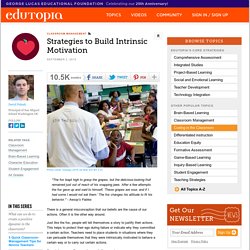
After a few attempts the fox gave up and said to himself, 'These grapes are sour, and if I had some I would not eat them.' The fox changes his attitude to fit his behavior. " - Aesop’s Fables There is a general misconception that our beliefs are the cause of our actions. Often it is the other way around. Just like the fox, people will tell themselves a story to justify their actions. Punishment, Rewards, and Commitment The issue with classroom management policies in most institutions is that it operates on a carrot-and-stick model.
The goal of self-persuasion is to create cognitive dissonance in the mind of the one being persuaded. Punishment In 1965, Jonathan Freedman conducted a study in which he presented preschoolers with an attractive, desired, "Forbidden Toy. " Weeks later, Freedman pulled the students out of class one by one and had them do a drawing test. Rewards. Metacognition. Print Version.
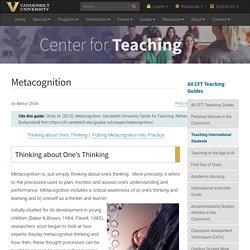
5 Highly Effective Teaching Practices. I remember how, as a new teacher, I would attend a professional development and feel inundated with new strategies.
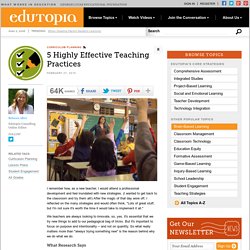
(I wanted to get back to the classroom and try them all!) After the magic of that day wore off, I reflected on the many strategies and would often think, "Lots of great stuff, but I'm not sure it's worth the time it would take to implement it all. " We teachers are always looking to innovate, so, yes, it's essential that we try new things to add to our pedagogical bag of tricks. But it's important to focus on purpose and intentionality -- and not on quantity. So what really matters more than "always trying something new" is the reason behind why we do what we do. What Research Says This leads me to educational researcher John Hattie, who wrote Visible Learning for Teachers: Maximizing Impact on Learning. Hattie has spent more than 15 years researching the influences on achievement of K-12 children. 1.
Deeper Learning Through Questions - The Right Question. Teaching Metacognition to Improve Student Learning. Metacognition can be a word that gets in the way of students’ understanding that this “thinking about thinking” is really about their awareness of themselves as learners.

Avoiding "Learned Helplessness" We all have students that just want to "get it right.
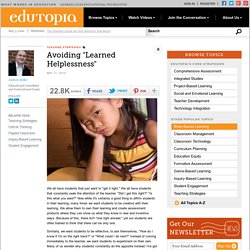
" We all have students that constantly seek the attention of the teacher. "Did I get this right? " "Is this what you want? " Metacognition: Nurturing Self-Awareness in the Classroom. How do children gain a deeper understanding of how they think, feel, and act so that they can improve their learning and develop meaningful relationships?

Since antiquity, philosophers have been intrigued with how human beings develop self-awareness -- the ability to examine and understand who we are relative to the world around us. Today, research not only shows that self-awareness evolves during childhood, but also that its development is linked to metacognitive processes of the brain. Making Sense of Life Experiences Most teachers know that if students reflect on how they learn, they become better learners.
For example, some students may think and process information best in a quiet library, while others may focus better surrounded by familiar noise or music. Metacognition plays an important role in all learning and life experiences. How do I live a happy life? Hands-Off Teaching Cultivates Metacognition. As a teacher, you put a lot of thought into how to make your class and the material as accessible and engaging as possible.
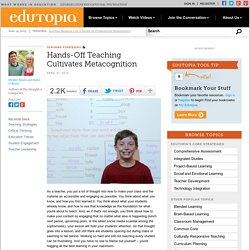
You think about what you know, and how you first learned it. Metacognition: Nurturing Self-Awareness in the Classroom. 5 Highly Effective Teaching Practices. Developing Students’ Self-Assessment Skills. December 10, 2014 By: Maryellen Weimer, PhD in Teaching Professor Blog I’ve been rereading some of the research on student self-assessment and thinking about how students develop these skills.
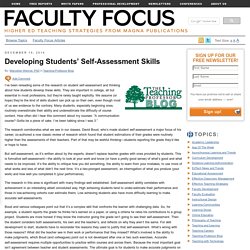
They are important in college, all but essential in most professions, but they’re rarely taught explicitly. We assume (or hope) they’re the kind of skills student can pick up on their own, even though most of us see evidence to the contrary. Many students, especially beginning ones, routinely overestimate their ability and underestimate the difficulty of course content. The research corroborates what we see in our classes. But self-assessment, as it’s written about by the experts, doesn’t replace teacher grades with ones provided by students. The research in this area is significant with many findings well established. Boud and various colleagues point out that it’s a complex skill that confronts the learner with challenging data. Prompts to Help Students Reflect on Learning. November 12, 2014 By: Maryellen Weimer, PhD in Teaching Professor Blog One of the best gifts teachers can give students are the experiences that open their eyes to themselves as learners.
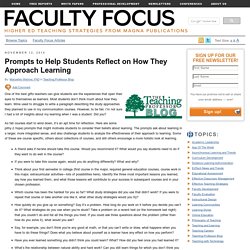
Most students don’t think much about how they learn. Mine used to struggle to write a paragraph describing the study approaches they planned to use in my communication courses. However, to be fair, I’m not sure I had a lot of insights about my learning when I was a student. As fall courses start to wind down, it’s an apt time for reflection. A friend asks if he/she should take this course.